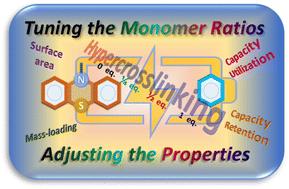Structure–property relationship in phenothiazine-based hypercrosslinked organic electrode materials through porosity adjustment
IF 9.5
2区 材料科学
Q1 CHEMISTRY, PHYSICAL
引用次数: 0
Abstract
A series of phenothiazine-based hypercrosslinked p-type porous polymers were synthesized via a knitting polymerization method, incorporating increasing amounts of benzene as a co-monomer for a systematic observation of the porosity–electrochemical performance relationship. The resulting materials, denoted as IEP-29, IEP-29-b/4, IEP-29-b/2, and IEP-29-b, correspond to PTz/benzene ratios of 1/0, 1/0.25, 1/0.5, and 1/1, respectively. The inclusion of benzene, acting as a structure directing co-monomer, significantly increased the crosslinking density and accessible surface areas, which varied from 29 m2 g−1 (IEP-29, no benzene) to 586 m2 g−1 (IEP-29-b, 1/1 ratio). However, this also resulted in reduced theoretical capacity, which decreased from 112 mA h g−1 (IEP-29) to 70 mA h g−1 (IEP-29-b), due to the incorporation of non-electrochemically active benzene units. Electrochemical testing in Li-cells revealed that increased crosslinking improved capacity utilization and high-rate capability, despite a moderate decline in gravimetric capacity. This study further explored the effect of increasing electrode mass loading (up to 50 mg cm−2) on electrochemical performance. Remarkably, IEP-29-b, the most crosslinked analogue, exhibited near-linear areal capacity scaling with minimal loss in gravimetric capacity as mass loading increased. At 50 mg cm−2, it achieved 3.5 mA h cm−2 along with excellent rate performance and cycling stability, retaining 71% of its capacity after 500 cycles at 2C. Importantly, the moderately crosslinked analogue (IEP-29-b/4) offered an optimal balance between specific gravimetric and areal capacities, delivering record-high values of 72.9 mA h g−1 (based on the total mass of the electrode) and 3.85 mA h cm−2, respectively – among the highest reported for p-type polymer cathodes in lithium cells. This work presents a cost-effective, scalable route to develop crosslinked, porous p-type hyperbranched polymers as high-performance cathodes with enhanced electrochemical properties at both the material and electrode levels. Therefore, this strategy paves the way for more commercially viable, high-capacity energy storage solutions.

孔率调节下吩噻嗪基超交联有机电极材料的结构-性能关系
采用编织聚合法制备了一系列以吩噻嗪为基础的高交联p型多孔聚合物,以增加苯为共聚物单体,系统地观察了多孔性与电化学性能的关系。得到的材料分别为IEP-29、IEP-29-b/4、IEP-29-b/2和IEP-29-b, PTz/苯比分别为1/0、1/0.25、1/0.5和1/1。作为结构导向共单体的苯的包合显著增加了交联密度和可达表面积,其变化范围从29 m2 g−1 (IEP-29,无苯)到586 m2 g−1 (IEP-29-b, 1/1比)。然而,这也导致了理论容量的降低,从112 mA h g - 1 (IEP-29)下降到70 mA h g - 1 (IEP-29-b),这是由于非电化学活性苯单元的掺入。锂电池的电化学测试表明,增加交联可以提高容量利用率和高倍率,尽管重量容量略有下降。本研究进一步探讨了增加电极质量负载(高达50 mg cm−2)对电化学性能的影响。值得注意的是,IEP-29-b(交联程度最高的类似物)表现出接近线性的面积容量缩放,随着质量载荷的增加,重量容量的损失最小。在50 mg cm - 2时,它达到3.5 mA h cm - 2,具有优异的倍率性能和循环稳定性,在2C下循环500次后保持71%的容量。重要的是,中等交联类似物(IEP-29-b/4)在比重和面积容量之间提供了最佳平衡,分别提供了创纪录的72.9 mA h g - 1(基于电极的总质量)和3.85 mA h cm -2,这是锂电池中p型聚合物阴极报道的最高值之一。这项工作提出了一种具有成本效益,可扩展的途径来开发交联,多孔p型超支化聚合物作为高性能阴极,在材料和电极水平上都具有增强的电化学性能。因此,这一策略为更具商业可行性的高容量储能解决方案铺平了道路。
本文章由计算机程序翻译,如有差异,请以英文原文为准。
求助全文
约1分钟内获得全文
求助全文
来源期刊

Journal of Materials Chemistry A
CHEMISTRY, PHYSICAL-ENERGY & FUELS
CiteScore
19.50
自引率
5.00%
发文量
1892
审稿时长
1.5 months
期刊介绍:
The Journal of Materials Chemistry A, B & C covers a wide range of high-quality studies in the field of materials chemistry, with each section focusing on specific applications of the materials studied. Journal of Materials Chemistry A emphasizes applications in energy and sustainability, including topics such as artificial photosynthesis, batteries, and fuel cells. Journal of Materials Chemistry B focuses on applications in biology and medicine, while Journal of Materials Chemistry C covers applications in optical, magnetic, and electronic devices. Example topic areas within the scope of Journal of Materials Chemistry A include catalysis, green/sustainable materials, sensors, and water treatment, among others.
 求助内容:
求助内容: 应助结果提醒方式:
应助结果提醒方式:


